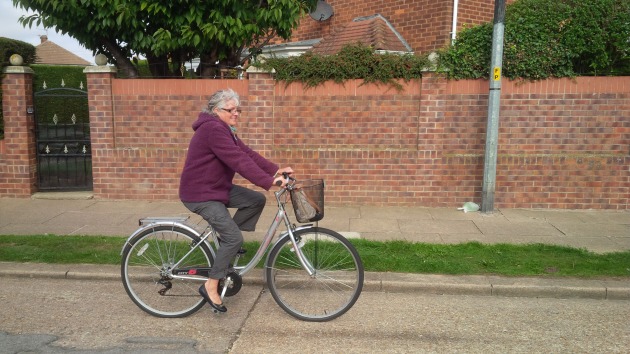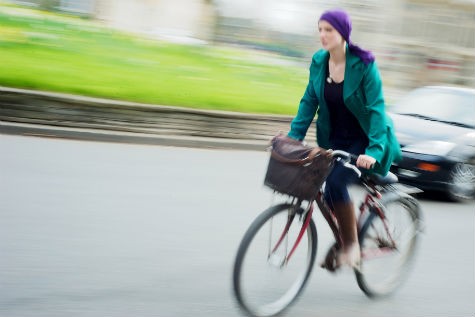Going shopping!
September 30, 2013 Leave a comment

Wrapped up for nipping to the shops!
Building Bike Culture in NE Lincolnshire
September 30, 2013 Leave a comment
This is the second in a series of ten videos from Copenhagenize.com, looking at the most important design elements in Copenhagen’s impressive bicycle culture.
Here we are with Episode 02 in our series about what design elements it takes to make Copenhagen a bicycle-friendly city.
Pedro Madruga, Environmental Engineer at Copenhagenize Design Co., talks about The Green Wave.
The Green Wave is coordinated traffic lights for cyclists. Ride 20 km/h and you won’t put a foot down on your journey into the city centre in the morning and home again in the afternoon.
On Nørrebrogade, the first street to feature the Green Wave, the number of cyclists increased by 15%. Traffic flow in the intense morning bicycle rush hour was improved, providing Citizen Cyclists with a smoother, more efficient journey.
Now, several major arteries leading to the city centre in Copenhagen feature the Green Wave for cyclists.
Think bicycle first and you’re on your way to a more bicycle-friendly city. The Green Wave is a key Design Element in the City of Copenhagen.
September 30, 2013 1 Comment
By Simon Ostler.
By making improvements along the whole river front between Grimsby and Cleethorpes, and by linking up the Healing and Humberston Pedalways, a circular route could be created which would come near to all the population of NE Lincs.
Improvements required to achieve this: At present many people enjoy the cycle route from Humberston along the Seawall to Cleethorpes but stop at Wonderland as the path peters out. This path could be extended with an improvement to the current seawall path so that it goes as far as Youngs Seafood Offices on the sea wall at the Fish Dock.
The path would then come off here and follow existing roads, some of which are already bicycle friendly roads as such untill it reached Westgate:
 Some sort of crossing of the Freshney would have to be made here maybe using the existing Westgate bridge on Alexander Dock side, as I believe the path is wide enough to accommodate this.
Some sort of crossing of the Freshney would have to be made here maybe using the existing Westgate bridge on Alexander Dock side, as I believe the path is wide enough to accommodate this.
A separate cycle lane would then be constructed along the verge on the A180 between Westgate and Moody lane linking it up to the bike path which already exists down Moody Lane. An improvement to cycle access to the sea wall could then be made which would connect all to off road cycling all the way to where the sea wall meets South Marsh Road.
The exit from the sea wall and South Marsh Road itself would need to be improved but this could then be followed all the way to Stallingborough.
In Stallingborough follow Station Road then turn right down Healing Road. The end of this would need improving into a bike path along the edge, improving the existing footpath, of the B1210 till Wisteria Drive Healing, follow this and Low Road through Healing until you connect up with the Healing Cycle Way.
Follow the Healing Cycle way all the way to ‘The Trawl’ then turn right down and then left (making both roundabouts cycle friendly)down Cambridge Road as this is wide and can accommodate an on road cycle path then along Westward Ho and onto Bargate, incorporating existing bike paths and improving where necessary.
The route would then go left down Weelsby Road, once again incorporating existing bike paths all the way to Love Lane where it would joint the Humberston Pedal Way till it got to the roundabout at the far end of North sea Lane. The route would then follow the path next to Pleasure Island to the sea front, so completing the 22 mile Circular Route of NE Lincs.
The main reason for this route would be recreational but by extending the Healing Pedalway to Stallingborough and creating a safe crossing over the Freshney along the A180 to Moody Lane this would be hugely increase the safety for many commuters.
This route would link the following areas in a safe circuit:
· Grimsby
· Cleethorpes
· Humberston
· Stallingborough
· Healing
· Little Coates
· Great Coates
· Wybers Wood
It would also make it a three hour circuit with lots of stops on the way.
September 29, 2013 Leave a comment
Thanks to Helen Naulls for providing the link to this article.
In the ideal world of segregated cycle paths, we wouldn’t need to worry about such a topic as this. Cycling would be safe and free from even thinking about sharing a narrow road with a big, heavy, dangerous lorry. That’s the aim of this blog – to contribute to getting us in NE Lincs to that Dutch cycling utopia.
However, back in the here-and-now, there are times when we have to cycle on roads with lots of heavy traffic, so this article, on London Cycling Campaign, provides good advice in such circumstances.
September 28, 2013 Leave a comment
This is the first in a series of ten videos from Copenhagenize.com, looking at the most important design elements in Copenhagen’s impressive bicycle culture. It features the very cool and famous (in cycling circles) Mikael Colville-Andersen, CEO of Copenhagenize Design Co.
It’s a very interesting and informative series, well worth watching for anyone interested in developing a bike culture here in NE Lincs.
September 26, 2013 Leave a comment
The Labour MP Ian Austin has called for cycling to feature as a central issue during the run-up to the 2015 general election, allowing each party to pitch its safety and infrastructure policies to the electorate.
Read the rest of this article, on road.cc, here.
September 24, 2013 Leave a comment
 You wouldn’t dress like a Formula One driver for the morning commute, so there’s no need to get kitted up for the Tour de France just because you’re riding to work!
You wouldn’t dress like a Formula One driver for the morning commute, so there’s no need to get kitted up for the Tour de France just because you’re riding to work!
You don’t need to spend a fortune, or be clad in head-to-toe lycra, to be a cycle commuter. The simple fact is: everyday cyclists wear everyday clothes. Check out the Copenhagen Cycle Chic website for proof – and inspiration!
Read the rest of this article on GoSkyride.com here.
September 23, 2013 1 Comment
The home page of The Cycling Embassy of Great Britain is very succinct and to the point:
“Cycling should be the simplest, easiest and most convenient way to get around in most places in the UK, and yet the reality is that it’s not – the roads are busy, and feel unsafe or unpleasant to ride on, and what cycle paths there are seem to take the long way round, or run out just when you need them most.
The Dutch and the Danes have demonstrated that it is easy to provide safe, attractive and efficient routes for cycling, away from fast traffic, which anybody and everybody – men and women, old and young, and rich and poor – want to use.
We at the Cycling Embassy of Great Britain want to see an end to cycling being pushed to the margins; we want to see a network of direct, well-designed, separated cycle routes that are safe even for young children to use.”
And the video that accompanies the above statement perfectly demonstrates the difference between cycling in the Netherlands and in the UK. The comparison is stark!
We completely support the CEoGB in making these points. Hopefully, as more and more people realise what we could have here in NE Lincs and call for it to happen, then the message will get through and we’ll see things improve.
September 23, 2013 1 Comment
This is a prime route for people living in Grimsby/Cleethorpes who work in Immingham or the Humber bank factories (or for those who live in Immingham and work in Grimsby, of course). I, like those few others who currently cycle this route, use the sea wall, getting on to it at Moody Lane, and coming off it near the East Gate, on Laporte Road.
The sea wall is OK, at least there’s very little motor traffic there, but it’s bumpy, uncomfortable, unlit at night, involves cycling on rough gravel tracks, is exposed to the wind and weather coming off the sea and is not as direct as it could be. Over the last several years, it’s also been closed for long periods (several weeks at a time) when environmental work has been conducted along the coast or at the pumping stations.
There is an obvious improvement that could be made on this key route. Laporte Rd becomes Hobson Way at the roundabout with Kiln Lane, and this road continues towards Grimsby until it suddenly ends in a dead end!
However, just a couple of hundred yards or so further on again is Moody Lane, the section that passes Blue Star Fibres and feeds in to the Moody Lane/Woad lane junction at Novatis.
If a cycle path was built linking Hobson Way with Moody Lane, there would be a direct cycle commute route from Grimsby to the main industrial areas of Immingham and the Humber bank factories. Obviously, this is where many people from the Grimsby area work, so by building this link path it would, for the first time, provide a dedicated cycling path from Grimsby to Immingham, and I’m certain it would enable and encourage many more cycling commuters to use it!
Problem: No dedicated cycling route from Grimsby to Immingham. The sea wall is inadequate in many respects (see above) and serves as a deterrent to many from cycling to work.
Solution: Build a smooth surfaced, lit cycle path link between Hobson Way and Moody Lane.
September 23, 2013 Leave a comment
More health benefits of cycling in this article on Bicycling.com.
Calorie burning and muscle building are the obvious ways cycling helps you drop unwanted pounds. But that’s just the beginning. Here are a few stealth and sometimes surprising ways that bicycling can help you shed body fat fast.
Read the rest of the article here.